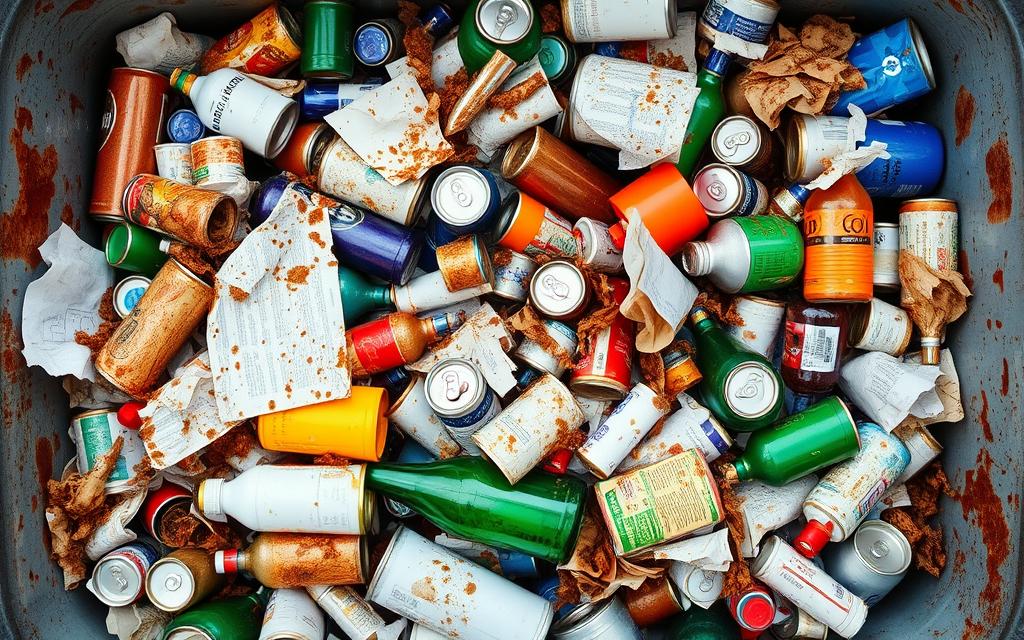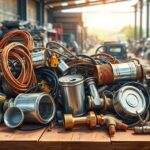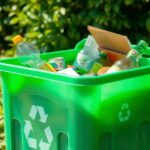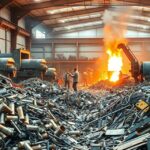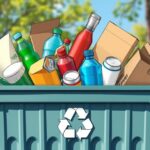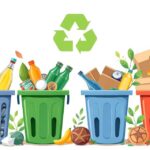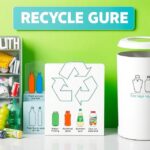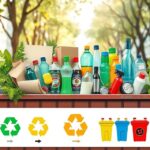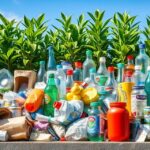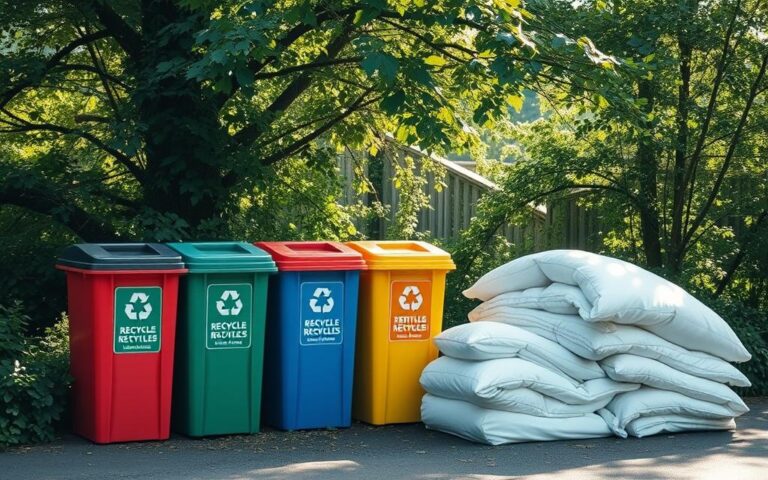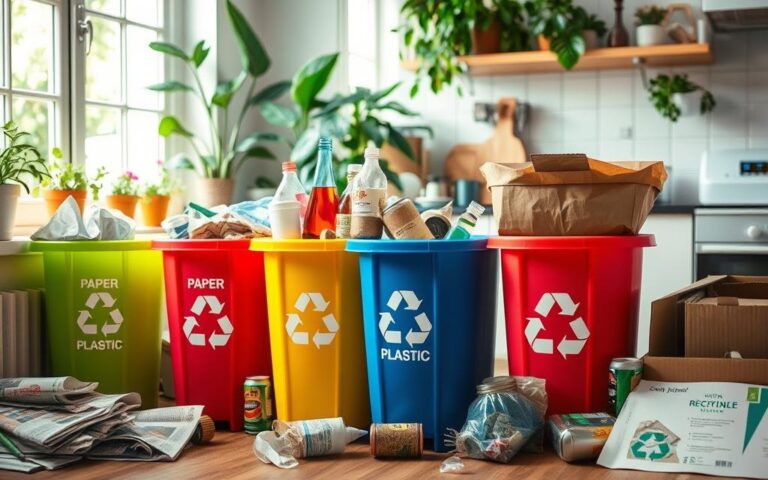What Happens If You Don’t Rinse Recycling? Impact on Quality
Rinsing your recycling is more important than you might think. Skipping this step can lead to a big problem called recycling contamination. This issue puts the hard work of whole neighbourhoods at risk because it can make entire batches of recyclables useless.
If recyclables are dirty, they might not be processed properly. This means that instead of being used again, they get thrown away. Experts say clean items are essential for recycling success. Even a tiny bit of food or drink left in a container can cause trouble.
The Institute of Scrap Recycling Industries has warned us. They say even 1% of contamination can spoil tons of recyclable material. This mistake can waste everyone’s recycling efforts.
Understanding the Recycling Process
To understand recycling, first know the importance of clean recyclables. Contaminants like leftover food make sorting hard. This increases costs and lowers recycling efficiency. In Chicago, rules are in place for residents to clean recyclables, showing cleanliness’s key role.
The Importance of Clean Materials
Keeping materials clean is crucial for smooth recycling. In single-stream recycling systems, all recyclables are collected together. This method has many single-stream recycling benefits, such as more people recycling and reduced collection costs. However, these systems can face issues.
Items not rinsed can leak and contaminate others, especially paper. A little residue, from yoghurts or oils, hurts paper recycling. Just a quick rinse helps keep recyclables clean.
Single-Stream Recycling Explained
In the UK, many households use single-stream recycling. It makes recycling easier for everyone. Yet, the risk of contamination is still high. Food residue can lead to the disposal of recyclables in landfills.
By rinsing, families help improve recycling efficiency. This cuts down waste in landfills. It also reduces costs for local councils, who handle waste disposal.
Recycle Coach, together with over 1,500 municipalities, offers tips on waste management. This effort aims to boost proper disposal practices. It promotes a cleaner, sustainable recycling process.
What Happens If You Don’t Rinse Recycling
Rinsing recycling stops big problems in the recycling process. Leftover food in bottles and containers can attract bugs and create dirty conditions. If recyclables are too dirty, they might be thrown away instead of recycled. Cleanliness is key for recycling.
Contamination Issues in Recycling
When recyclables aren’t clean, it causes contamination issues. Sorting facilities have to spend more to process dirty items. If things are too contaminated, they end up in landfill, wasting resources. Plastic bags also need to be clean and dry to avoid ruining other materials.
Consequences for Recyclable Materials
Dirty recyclables can be rejected, lowering their value. Recycling programs may struggle and face higher costs. A waste study in 2019 found food waste and non-recyclable items as common culprits. Proper rinsing could prevent these issues.
The Role of Contaminants in Recycling Quality
The cleanliness of materials is crucial for recycling quality. Contaminants greatly affect the recycling process. They also influence whether the recycling system can sustain itself. Knowing the common types of contamination is key to improving recycling quality.
Defining Recycling Contamination
Recycling contamination happens when non-recyclable or dirty items mix with recyclable ones. This lowers the quality of recyclables. Food waste, due to remains on containers, is a major contaminant. It presents challenges in processing and raises costs.
Common Contaminants Found in Recycling
Several common recycling contaminants include:
- Leftover food and greasy containers, bad for recycling paper and cardboard
- Liquids that spoil other recyclable items
- Plastic bags that jam machinery
- Items thought to be recyclable but are not, known as ‘wishcycling’
Many recycled materials are affected by these problems. For example, one in four items in recycling bins goes to a landfill because of contamination. This concern affects efficiency and safety at Material Recovery Facilities (MRFs). Workers spend a lot of time removing contaminated items by hand. This exposes them to dangers and raises the cost of processing.

The Economic Impact of Non-Rinsed Recycling
Choosing not to rinse recyclables affects recycling centres financially. As contamination in recycled items increases, facility processing costs go up. Sorting machines often get stuck due to dirty items, leading to costly repairs and stoppages. Moreover, some loads might go to landfills if they’re too contaminated. This reduces the recyclable materials’ value and profits.
Processing Costs for Facilities
Dirty recyclables make facility expenses soar. Centres have to pay extra for staff to sort and clean. This misstep costs U.S. recycling centres about $300 million each year in extra labour and repairs.
Reduced Value of Recyclable Materials
Contamination drops the worth of recyclable goods. Clean, correctly sorted items sell for more. Rising costs might push communities to either pay more for recycling or participate less. This threatens the recycling’s economic sense and contributes to more landfill waste. Everyone loses when there are contamination issues.
To fight bad recycling habits, education is key. Local authorities need to tell residents how their actions affect recycling. Learning the right way to recycle can help a local area’s recycling economy. For tips on proper recycling, see this guideline.
How to Properly Prepare Recycling
Getting recycling right means making sure things are clean and ready for re-use. It’s important to rinse well to avoid problems. Knowing the right way to do this makes it more likely for items to be recycled.
Rinsing and Cleaning Guidelines
Here’s how to prep for recycling:
- Empty all containers to get rid of leftovers.
- Rinse out things like bottles and food pots to keep them from spoiling other items.
- Make sure plastic bags are clean and not wet; otherwise, they could ruin the whole recycling batch.
- Paper needs to be pretty clean too, so avoid trying to recycle very messy items.
Washing items might use water, but it doesn’t need much. Cleaning a single bottle each day uses about 34 gallons yearly. Recycling centers clean them again, so your effort is not wasted.
Common Mistakes to Avoid
There are easy mistakes that can mess up the recycling process:
- Don’t put oily boxes or dirty paper in the recycling bin.
- Not all plastics can be recycled. Check what your area accepts to stay on track.
- Don’t bag up your recyclables. They need to be loose.
To do better at recycling, know what your area accepts. Talking to local services helps. They explain the dos and don’ts, ensuring you recycle properly.
Conclusion
Rinsing recyclables helps keep the recycling process efficient. Recycling importance is closely linked with managing contaminants. These contaminants can lower the recycling’s effectiveness.
By cleaning out containers, people boost the value of materials recycling facilities process. This effort ensures fewer items are thrown away as trash.
Learning about proper recycling practices enables people to help ensure a greener tomorrow. Surprisingly, 94% of Australians find recycling correctly challenging. This emphasizes the need for better awareness and education on recycling. Each simple action, like washing containers, is crucial in tackling the broader waste issue.
Adopting correct recycling habits makes the recycling industry more efficient. Communities coming together to make eco-friendly choices can lessen the environmental impact of waste. This leads to a cleaner, sustainable future. The message is clear: every single effort is important in our common goal for better recycling and environmental care.
FAQ
Why is rinsing recyclables important?
It’s key because it removes leftover food and liquids. These can spoil a whole batch of recycling. If the batch gets contaminated, it might end up in a landfill instead.
What are the consequences of not rinsing recyclable materials?
Dirty recyclables can attract bugs and cause health issues. If they’re not clean, the whole load may be tossed. This wastes resources and hits recycling facilities in their wallets.
How does contamination affect the recycling process?
It lowers the quality of materials we can recycle. A bit of contamination can rule out a large batch. Thus, it can slow down the whole recycling effort.
What types of contaminants are commonly found in recycling?
We often see food leftovers, drink spills, oily papers, and items like plastic bags which can’t be recycled. They mess up the sorting and make more waste.
What are the economic implications of not rinsing recyclables?
Dealing with dirty recyclables costs more in labour and getting rid of waste. Stuck machinery from messes also means expensive fixes. This can make recycling pricier for everyone.
How can I prepare my recyclables properly?
Make sure to empty and clean containers before recycling. Check what your local rules say. Avoid putting stuff like oily pizza boxes in the recycle bin.
What is single-stream recycling?
This system lets people put all recyclables in one bin. It’s easier and cheaper to collect. But, if not done right, different items can contaminate each other.
How does recycling contamination impact environmental sustainability?
Contamination means more stuff goes to dumps not for recycling. It wastes what we could reuse. More dumping also leads to extra pollution from transport and managing waste.

